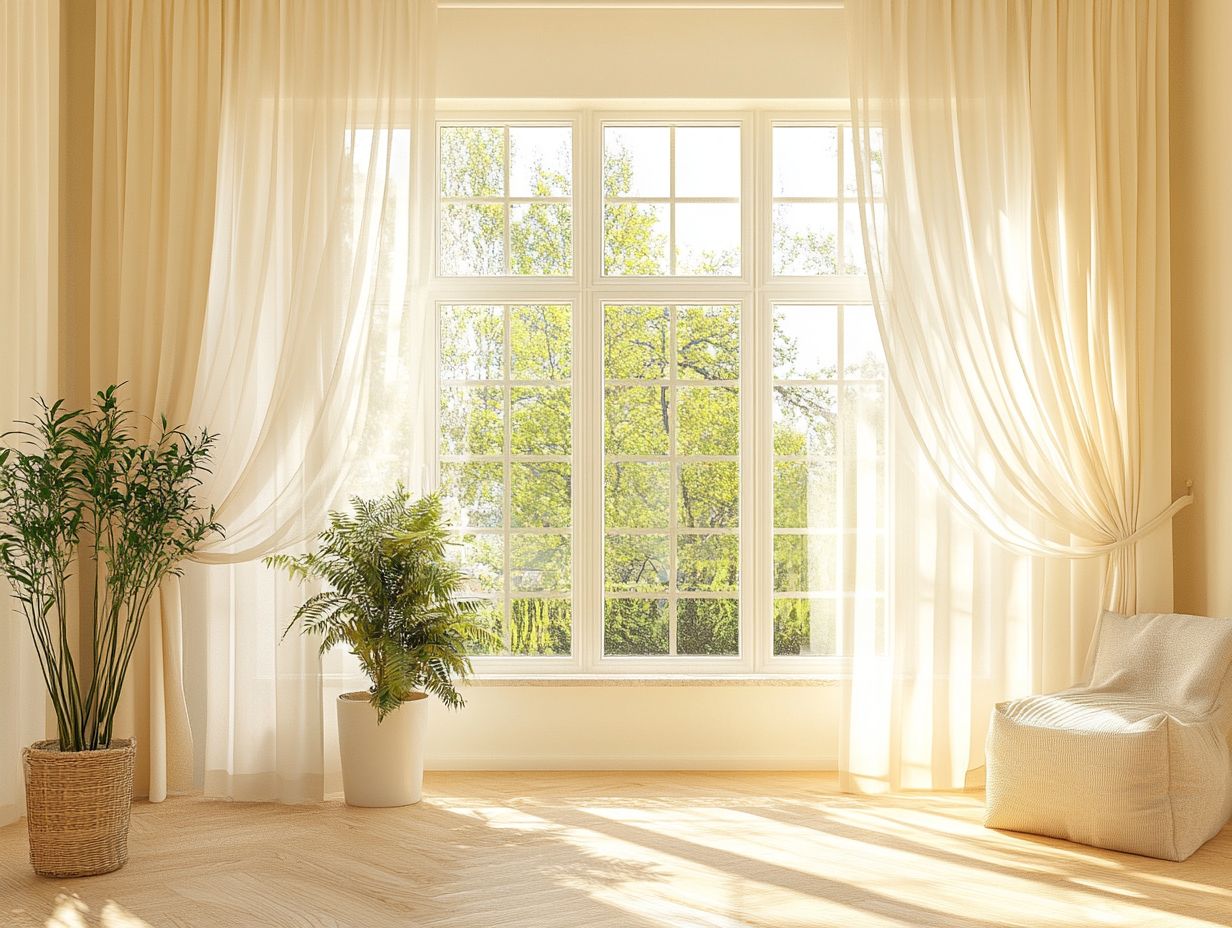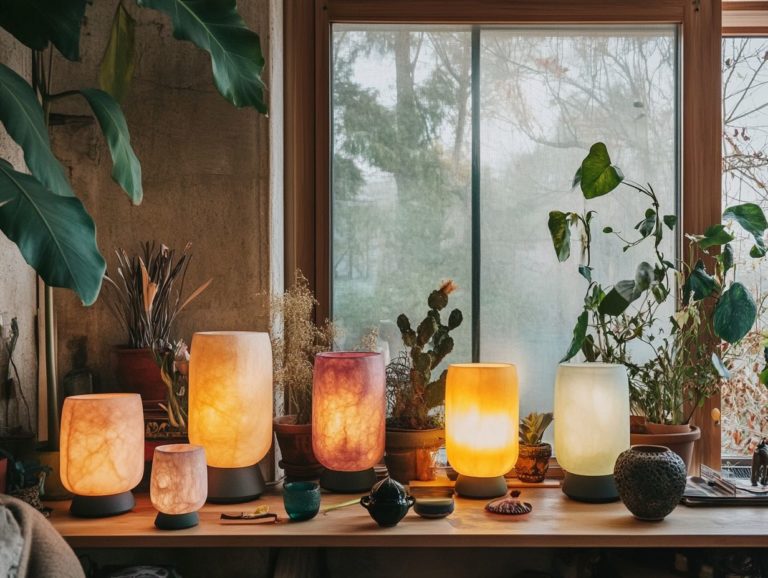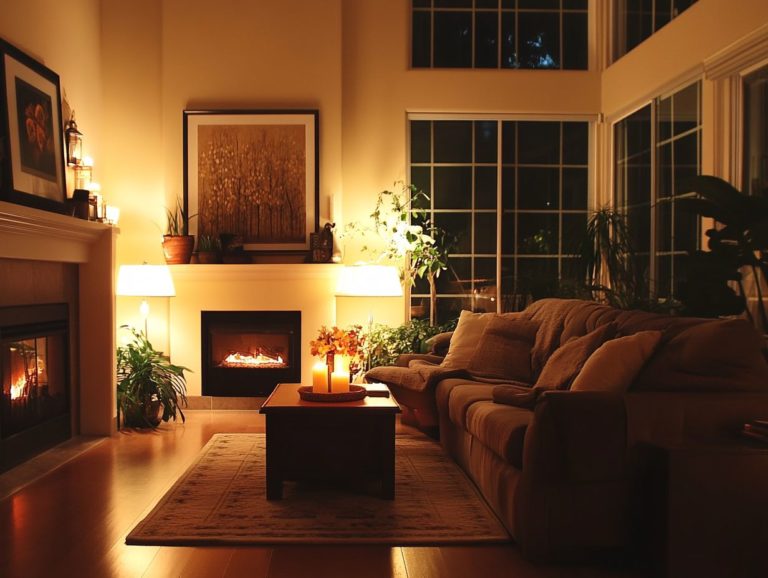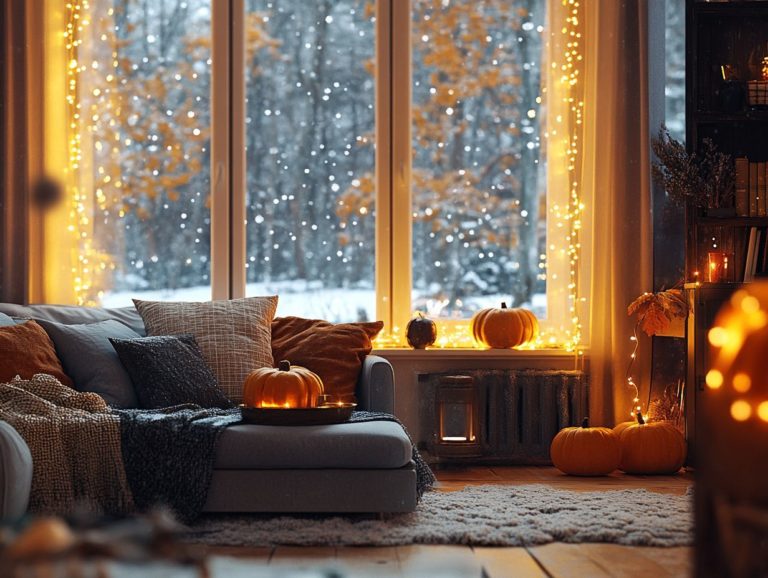“How to Use Natural Light to Enhance Your Space”
Natural light profoundly influences the ambiance and functionality of your spaces. Understanding its benefits can transform your home into a brighter, more inviting haven.
This exploration delves into what natural light is, its advantages in interior design, and practical tips for maximizing its presence in your environment.
From assessing your space to optimizing window placement and selecting the right treatments, you ll discover how to harness the power of sunlight effectively.
You will also learn how to integrate natural light into your overall lighting design for a harmonious living space. Get ready to brighten up your home like never before! Let s dive in!
Contents
- Key Takeaways:
- Understanding Natural Light
- Maximizing Natural Light in Your Space
- Using Reflective Surfaces to Enhance Natural Light
- Pick the Perfect Window Treatments for Your Dream Space!
- Incorporating Natural Light into Your Lighting Design
- Frequently Asked Questions
- What are the benefits of using natural light to enhance your space?
- How can I maximize natural light in my space?
- Are there specific times of the day when natural light is most effective?
- What types of window coverings are best for allowing natural light in?
- How can I incorporate natural light into my home office or workspace?
- Can I use natural light to enhance my outdoor living space?
Key Takeaways:

- Natural light enhances a space by creating a sense of spaciousness, improving mood and health, and reducing energy costs.
- Assess your space for natural light and maximize its potential through strategic window placement, reflective surfaces, and appropriate window treatments.
- Combining natural light with artificial sources creates a balanced, functional space. Consider using light-filtering options for a softer glow.
Understanding Natural Light
Understanding natural light is key for homeowners who want to brighten their spaces and save energy. It does more than just brighten your interiors; it contributes significantly to a harmonious ambiance that can elevate your overall happiness and well-being.
By strategically incorporating natural light, you not only align with principles like Vaastu Shastra (a traditional Indian architectural system) and Feng Shui (an ancient Chinese practice that promotes harmony with the environment), but also cultivate an environment that fosters positivity. Many overlook the benefits of natural light, which include boosting your mood and potentially alleviating issues such as seasonal affective disorder.
Therefore, recognizing its significance in interior design is crucial for creating a balanced home environment.
What is Natural Light?
Natural light is the sunlight that streams into your home or building, illuminating your spaces without the need for artificial lighting.
This dynamic form of light shifts in intensity and color temperature throughout the day, casting unique shadows and hues that can dramatically transform the ambiance of any room. In the morning, it typically bathes your space in a soft, warm glow, while midday delivers brighter, cooler tones. This variability not only enhances the aesthetic charm of your interiors but also promotes energy efficiency by reducing your reliance on electric lighting.
By incorporating large windows, skylights, or open spaces, you can harness natural light to complement various interior design elements, creating a harmonious blend that elevates the overall atmosphere of your space.
Benefits of Natural Light in Interior Design
The advantages of incorporating natural light in your interior design go far beyond just looking good; they truly elevate your happiness and enhance energy efficiency in your space.
By allowing ample daylight to flood your rooms, you not only brighten your surroundings but also cultivate a sense of well-being, significantly boosting your mood and motivation. This link between natural light and mental health is particularly crucial for anyone dealing with seasonal affective disorder, as sunlight exposure can help ease symptoms and create a more vibrant living environment.
Sustainable interior design takes this a step further by harnessing natural resources. Thoughtful window placement and the use of translucent materials can minimize your reliance on artificial lighting, reducing energy consumption. This approach doesn t just benefit the environment; it also enriches your quality of life.
Maximizing Natural Light in Your Space
Maximizing natural light in your space is crucial for cultivating a vibrant and inviting atmosphere. Not only does it enhance your interior design, but it also brings health benefits and boosts energy efficiency.
By embracing sunlight, you create an environment that is both aesthetically pleasing and beneficial to your well-being.
Assessing Your Space for Natural Light

Assessing your space for natural light means you ll need to evaluate the orientation of your windows, the available openings, and the potential for sunlight to brighten your home.
Start by observing how sunlight moves through different rooms during the day. Take note of the direction sunlight streams in during peak hours and consider how nearby structures like trees, buildings, or fences might cast shadows that influence indoor brightness.
To enhance natural light, you might find that widening existing openings or strategically placing mirrors to reflect light deeper into your spaces can work wonders. You can also adjust your furniture layout to maximize sunlight exposure, making your space feel brighter and more inviting.
Optimizing Window Placement and Size
Optimizing your window placement and size is essential for maximizing natural light. This allows sunlight to flood your space while enhancing energy efficiency.
By strategically selecting larger windows in areas that receive ample daylight and positioning them on southern or western walls, you can significantly boost the flow of natural light. Consider the height of your windows; taller designs can capture sunlight from higher angles, especially during those shorter winter days.
Besides standard windows, incorporating glass doors can further amplify light intake and create an airy atmosphere. Ensure these doors are perfectly positioned to face outdoor spaces like gardens or patios. This not only brings more light indoors but also creates a seamless connection with nature.
Using Reflective Surfaces to Enhance Natural Light
Utilizing reflective surfaces to amplify natural light can significantly elevate your interior design. This approach makes your space feel bigger and enhances how light bounces off surfaces, enriching the overall ambiance of your home.
Strategic Placement of Mirrors and Other Surfaces
Strategically placing mirrors and other reflective surfaces can significantly boost natural light in any room. This creates an inviting ambiance that enhances your overall decor style.
By thoughtfully positioning these elements across from windows or light sources, you can amplify sunlight, allowing it to dance across walls and brighten even the darkest corners.
This technique not only brightens the space but also draws attention to your color schemes, especially those with lighter tones that enhance brightness and warmth. The interplay of light reflecting off surfaces can create a more expansive feeling, making smaller rooms seem larger.
It s also essential to consider the frame style and material of the mirrors. They can either complement or contrast your existing decor, contributing to a cohesive look that truly pleases the eye.
Pick the Perfect Window Treatments for Your Dream Space!
Selecting the ideal window treatments is essential for achieving the perfect balance of natural light in your home. This choice enables you to filter sunlight, enhances energy efficiency, and preserves your privacy.
Light Filtering vs. Light Blocking Options

Light filtering and light blocking options in window treatments offer distinct choices that influence the amount of natural light you invite in and your home’s energy efficiency.
These treatments not only elevate the aesthetic appeal of your spaces but also play a crucial role in regulating indoor temperatures and ensuring privacy. Light filtering options gently diffuse sunlight, creating a warm and welcoming ambiance while still allowing for some privacy.
Conversely, light blocking options completely eliminate sunlight, making them ideal for bedrooms or media rooms where total darkness can enhance your relaxation or entertainment experience.
By understanding the benefits of each type, you can make informed decisions that align perfectly with your lifestyle and personal preferences.
Styles and Materials to Consider
When selecting window treatments, the styles and materials you choose can significantly impact the aesthetic appeal and energy efficiency of your space.
Discover a range of popular styles that will transform your space! For instance, sheer fabrics offer a light, airy feel, allowing natural light to filter in and create a warm ambiance. On the flip side, darker, heavier materials provide privacy and light control, making them ideal for cozy environments.
You ll find various styles, from classic draperies to modern roller shades, each adding its unique flair. Roman shades, for example, can elevate your decor with their tailored look while also offering insulation benefits.
By exploring eco-friendly materials, you not only contribute to sustainability but also enhance the overall vibe of the room, ensuring it s both stylish and environmentally conscious.
Incorporating Natural Light into Your Lighting Design
Using natural light alongside your lighting design can create a better atmosphere. This approach enables you to create a balanced and functional living space that enhances the overall ambiance.
Combining Natural and Artificial Light Sources
Combining natural and artificial light sources is key to crafting a well-lit environment that exudes both comfort and functionality. This harmonious blend enhances both aesthetic appeal and usability.
For example, in your home office, strategically placing your desk near a window invites abundant daylight. Layered artificial lighting from a desk lamp offers focused illumination for those late-night work sessions.
In living areas, using a mix of skylights and stylish floor lamps can create an inviting ambiance, making your space feel both cozy and vibrant. By thoughtfully integrating these types of light, you can effectively boost mood and productivity, striking a perfect balance between relaxation and creativity.
Creating a Balanced and Functional Lighting Plan
Creating a balanced and functional lighting plan requires understanding both natural light sources and the strategic use of artificial lighting to achieve optimal energy efficiency.
Start by assessing the layout of your space, paying close attention to windows and openings that invite sunlight in. By analyzing how daylight interacts with your environment throughout the day, you ll pinpoint key areas that could benefit from natural illumination.
Next, consider incorporating task lighting think desk lamps or under-cabinet lights to enhance specific functions while keeping energy consumption in check. Utilizing dimmers and smart controls can elevate your lighting experience, allowing you to make adjustments that seamlessly blend natural and artificial elements.
This approach creates an ambiance that is not only visually appealing but also functional and energy-efficient.
Frequently Asked Questions

What are the benefits of using natural light to enhance your space?
- Increases overall brightness and warmth of a room.
- Reduces energy costs.
- Improves overall mood and well-being of occupants.
How can I maximize natural light in my space?
- Strategically place furniture to allow light to flow freely into the room.
- Use light-colored walls and reflective surfaces to bounce light around the space.
Are there specific times of the day when natural light is most effective?
- The best time to take advantage of natural light is during the golden hours, which occur during sunrise and sunset when the sun is low in the sky and produces a warm, soft light.
What types of window coverings are best for allowing natural light in?
- Lightweight, sheer curtains or blinds are great options for maximizing natural light while still providing privacy.
- Window films or tinting can help reduce glare and harsh sunlight.
Transform your space today! Contact us to explore the best window treatments for your home.
How can I incorporate natural light into my home office or workspace?
Choose a room with a window as your workspace. Position your desk near the window to let natural light illuminate your area.
You can also add extra lights to help when there isn’t enough sunlight!
Can I use natural light to enhance my outdoor living space?
Absolutely! Bring more natural light into your outdoor areas with skylights or solar-powered lights.
Arrange your outdoor furniture strategically to let that sunshine in!






